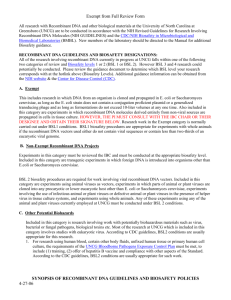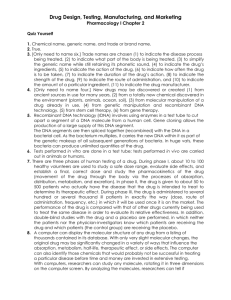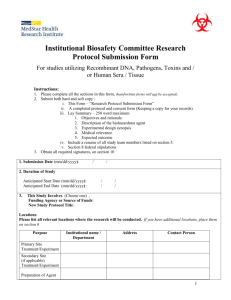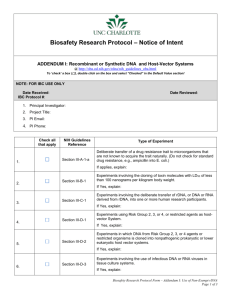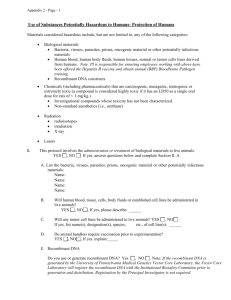Biological Materials and Recombinant DNA Protocol
advertisement
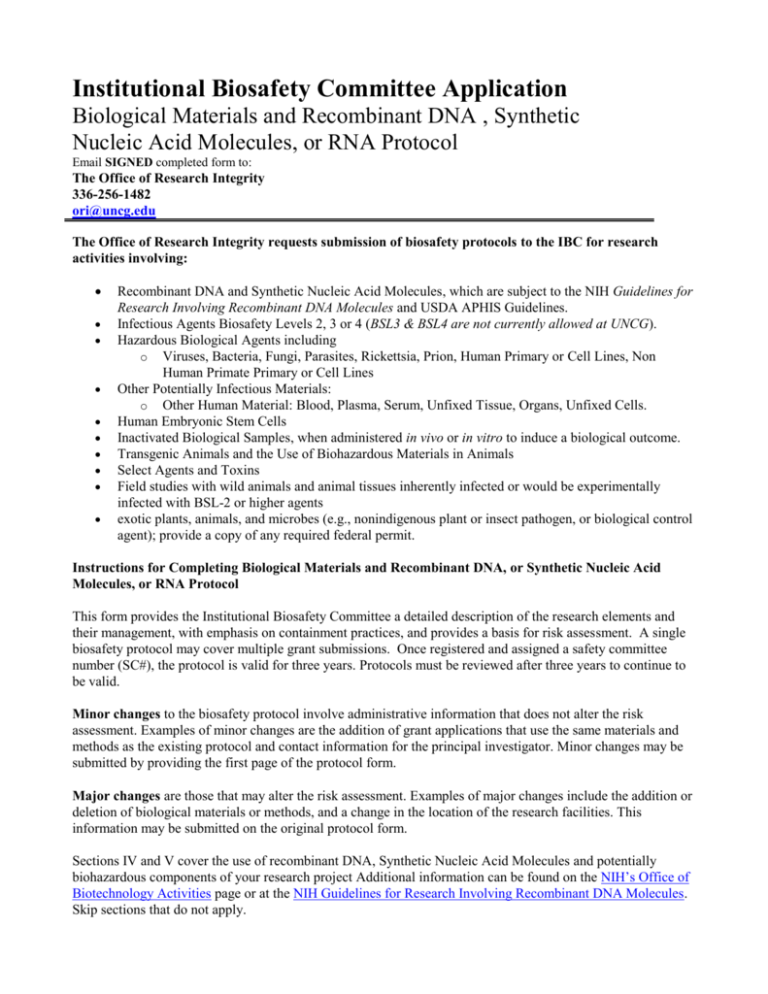
Institutional Biosafety Committee Application Biological Materials and Recombinant DNA , Synthetic Nucleic Acid Molecules, or RNA Protocol Email SIGNED completed form to: The Office of Research Integrity 336-256-1482 ori@uncg.edu The Office of Research Integrity requests submission of biosafety protocols to the IBC for research activities involving: Recombinant DNA and Synthetic Nucleic Acid Molecules, which are subject to the NIH Guidelines for Research Involving Recombinant DNA Molecules and USDA APHIS Guidelines. Infectious Agents Biosafety Levels 2, 3 or 4 (BSL3 & BSL4 are not currently allowed at UNCG). Hazardous Biological Agents including o Viruses, Bacteria, Fungi, Parasites, Rickettsia, Prion, Human Primary or Cell Lines, Non Human Primate Primary or Cell Lines Other Potentially Infectious Materials: o Other Human Material: Blood, Plasma, Serum, Unfixed Tissue, Organs, Unfixed Cells. Human Embryonic Stem Cells Inactivated Biological Samples, when administered in vivo or in vitro to induce a biological outcome. Transgenic Animals and the Use of Biohazardous Materials in Animals Select Agents and Toxins Field studies with wild animals and animal tissues inherently infected or would be experimentally infected with BSL-2 or higher agents exotic plants, animals, and microbes (e.g., nonindigenous plant or insect pathogen, or biological control agent); provide a copy of any required federal permit. Instructions for Completing Biological Materials and Recombinant DNA, or Synthetic Nucleic Acid Molecules, or RNA Protocol This form provides the Institutional Biosafety Committee a detailed description of the research elements and their management, with emphasis on containment practices, and provides a basis for risk assessment. A single biosafety protocol may cover multiple grant submissions. Once registered and assigned a safety committee number (SC#), the protocol is valid for three years. Protocols must be reviewed after three years to continue to be valid. Minor changes to the biosafety protocol involve administrative information that does not alter the risk assessment. Examples of minor changes are the addition of grant applications that use the same materials and methods as the existing protocol and contact information for the principal investigator. Minor changes may be submitted by providing the first page of the protocol form. Major changes are those that may alter the risk assessment. Examples of major changes include the addition or deletion of biological materials or methods, and a change in the location of the research facilities. This information may be submitted on the original protocol form. Sections IV and V cover the use of recombinant DNA, Synthetic Nucleic Acid Molecules and potentially biohazardous components of your research project Additional information can be found on the NIH’s Office of Biotechnology Activities page or at the NIH Guidelines for Research Involving Recombinant DNA Molecules. Skip sections that do not apply. In Section V, please provide an overview of the project and a detailed description of the practices employed in the management of biohazardous elements; discuss safety aspects of facility, containment equipment, personnel practices, and staff training that will ensure safe conduct of the investigation. PLEASE NOTE: The deliberate transfer of a drug resistance trait to a microorganism, when such a transfer could compromise the use of the drug to control disease agents in humans, veterinary medicine, or agriculture, is a Major Action (see Section III-A-1-a of the NIH Guidelines). Because of the potential implications for public health, animals or agriculture such experiments warrant special review. EXEMPT IBC RESEARCH AT UNCG If your research is Exempt (BSL1), you will need to complete the Exempt application located on our website and submit to file with the Office of Research Integrity. This includes research in which DNA from an organism is cloned and propagated in E. coli or Saccharomyces cerevisiae, as long as the E. coli strain does not contain a conjugation proficient plasmid or a generalized transducing phage and as long as fermentations do not exceed 10-liter volumes at any one time. Also included in this category are experiments in which recombinant DNA molecules derived entirely from non-viral sources are propagated in cells in tissue culture. THE PI MUST CONSULT WITH THE IBC CHAIR OR THEIR DESIGNEE AND OBTAIN THEIR SIGNATURE ON THE EXEMPT FORM Research work in the Exempt category is normally carried out under BSL1 conditions. BSL1 biosafety procedures are appropriate for experiments with whole animals if the recombinant DNA vectors used either do not contain viral sequences or contain less than two-thirds of an eucaryotic viral genome. Biological Materials and Recombinant DNA Protocol, Synthetic Nucleic Acid Molecules, or RNA Protocol Institutional Biosafety Committee (Please submit this signed application via email to ori@uncg.edu) I. CORE REGISTRATION INFORMATION Name of Principal Investigator (PI): Job Title: Office Phone: Lab Phone: Fax: Department: Box #: Campus Address: Email Address: CITI Training: Name of Co-PI(s): CITI Training for Co-PI(s): Protocol Type New Amendment Renewal Applicable Registration Number & Review Date Training Amendment or Renewal SC# Review date General Protocol Title: Grant Title(s): Granting Agency(s): Grant #: II. RESEARCH FACILITIES Location: Where are experiments performed? Is there anything unique about the location that allows the use of special precautionary measures such as an autoclave, containment facilities or biological safety cabinets? [NOTE: The OFFICE OF RESEARCH INTEGRITY requires prior notification, via written amendment to this protocol, regarding any change in location.] Building Name Room Number Use of Room Containment Equipment (autoclave, biosafety cabinet, fume hood, clean bench, other) Other III. LABORATORY/ADMINISTRATIVE PERSONNEL List personnel involved with work covered under this research registration; include lab personnel: investigators, students, and research staff. Please mark (asterisk) the lab supervisor or administrative coordinator who should be contacted for information about this protocol. Last name/First name Job Title Phone number CITI Training IV. RESEARCH ELEMENTS (Skip sections that do not apply) Do you plan to work with select agents or toxins? Please be aware that BSL3 and BSL4 agents are currently not approved for use at UNCG. I plan to use select agents or toxins I do NOT plan to use select agents or toxins Dual Use Research of Concern (DURC) The National Science Advisory Board for Biosecurity (NSABB) defines dual use research (DUR) as “…research that yield[s] information or technologies with the potential to be misused to threaten public health or national security.” DURC is defined as a subset of all DUR and refers to seven classes of experiments with significant potential to threaten public health or national security. Please answer each of these questions. Yes Would the research demonstrate how to render a vaccine ineffective? Would the research confer resistance to therapeutically useful antibiotics or antiviral agents? Would the research enhance the virulence of a pathogen or render a non-pathogen virulent? Would the research increase the transmissibility of a pathogen? Would the research alter the host range of a pathogen? Would the research enable the evasion of diagnostic/detection modalities? Would the research enable the weaponization of a biological agent or toxin? No A. Recombinant DNA or Synthetic Nucleic Acid Molecules Describe the rDNA constructs below in Section V. “Research Protocol Description.” Include a description, in molecular terms (e.g. promoter[s], ORFs, selectable markers), of the rDNA construct and provide a map if available. It is not necessary to provide details about every construct; categorical descriptions that are useful in assessing risks are acceptable. Describe the method of transfer or transfection. Describe measures taken to prevent or minimize expression of pathogenic/infectious sequences. Please avoid or explain acronyms. A(i) Gene Source(s) Nature of Insert or Protein expressed Gene Source(s) Gene Name (Genus, species, strain) Explain acronyms (e.g. GFP - green fluorescent protein) Use of Construct Cloning for sequencing, PCR Expression in a microbe Expression in OTCC Expression assoc. w/ Organism (Toxin, marker trait, virulence factor, DNA repair gene, oncogene, transcription factor, etc.) A(ii). Vector Description(s) Attach a construct map if available. General Description: Gene Transfer Method Vector Backbone Source Vector Technical Name Include (Conjugation; liposome; electroporation, viral infection, CaPO4, polyplexes, naked DNA uptake, etc.) (Bacterial plasmid, cosmid, phage, virus, synthetic, YAC, BAC, transposon, etc.) Include genus and species of source if applicable commercial vendor if applicable (e.g., pLXSN - Clontech) A(iii). Guidelines Assessment Assess the appropriate physical and biological containment. State the appropriate biological safety level(s). See BMBL for definitions. Support your assessment of any unusual potential hazards by citing the relevant subsection(s) of the current NIH Guidelines and/or USDA APHIS Guidelines. Currently, UNCG does not allow any work with BSL3 and BSL4 agents. BSL-1 B. Microbiological Agents Identify agents and mark (y/n) in appropriate categories.* Include microbes used to propagate recombinant plasmids and vectors or produce foreign proteins as described in section IV.A. above. Microbe Source (Genus, species, strain) Human Pathogen* Animal Pathogen* Plant Pathogen* Toxin Production* Large Scale Production >10 liters* Recipient of rDNA construct* Y Y Y Y Y Y Y Y Y Y Y Y Y Y Y Y Y Y N N N N N N N N N N N N N N N N N N Exposure Prophylaxis For each microorganism, consider the consequences of an accidental exposure, i.e., mucosal splash, inhalation, or inoculation, which might occur during experimental handling. Consider that organisms normally not pathogenic for healthy humans may become so when the natural barriers to infection are circumvented. Prepare a response procedure. It could be a simple matter of washing the wound with soap and water, or it could involve reporting to a health service. Is a particular antibiotic preferred and readily available? The exposure response plan should be posted in the laboratory. In the event of an accident, inform the Office of Safety. Microbe Exposure Response C. Organ, Tissue or Cell Cultures (OTCC) Identify species source, passage, and mark (y/n) in appropriate categories.* UNCG considers Human Cell Lines to be BSL-2. E.coli K-12 strains are BSL-1 and as such do not require IBC approval, but require the completion of an Exempt application on file with the ORI. OTCC Source Technical Name of OTCC (Genus, species, strain) (e.g. 3T3NIH, HepG2) Passage Comment (primary, established, immortal) (transforming, oncogenic, helper) Recipient of rDNA* Recipient of Microbe* (transient/stable) Y Y Y N N N Y Y Y N N N D. Research Organisms - Vertebrates, Invertebrates, or Plants Identify organisms and mark (y/n) in appropriate categories.* Organism Recipient of rDNA construct* (Genus, species, strain) (germ line or somatic transformation) Recipient of Microbe* Y Y Y N N N Recipient of OTCC* Y Y Y N N N E. Chemicals Administered to Vertebrates, Invertebrates, Plants or OTCC Identify chemicals and mark (y/n) in appropriate categories.* Nature of Chemical (carcinogens, mutagens, drugs, pesticide or toxins, etc). Chemical Name Route of Admin. (IV, IP, etc.) Highest Concentration Administered Administered to Microbe* Y Y Y N N N Administered to OTCC* Y Y Y N N N Administered to Organism* Y Y Y F. Disposal Describe the method of disposal of hazardous substances (e.g., incineration, autoclaving, chemical disinfection). If chemical disinfectant is used, state kind and concentration. Is autoclave monitored with biological indicator (e.g., spore strips)? Disposal Substance Disposal method/procedure N N N Chemical Hygiene Plan Does your laboratory have a Chemical Hygiene Plan? If no, please contact the Office of Safety at 336334-4357. YES: NO: V. RESEARCH PROTOCOL DESCRIPTION A. Design and objectives Briefly describe the experimental design and research objectives, tying together the research materials described above. B. Potential environmental impact Please describe aspects of the protocol which have potential environmental impact. If you plan to conduct a field trial, include the location and size of the environmental release. C. Description of safety precautions Describe methods for handling rDNA materials and/or hazardous substances. If you will be employing exotic organisms, or Risk Group 2 or 3 pathogenic microorganisms, give particular attention to the following: Adequacy of facility design and containment equipment, decontamination and disposal, investigator experience, personnel practices such as use of personal protective equipment, staff training, and Laboratory Standard considerations. Proposed Start Date:______________End Date______________ I have read, understand, and agree to abide by the institutional/federal regulations when working with the hazardous agents described therein. I understand the nature of the hazard associated with the agent(s) under this protocol. I understand that disregard for the policies and procedures as outlined in this protocol could result in dismissal from work with the designated hazardous agents. Check this box if you have designated any portions of this protocol as confidential to protect proprietary or patentable information. ______________________________________ Date ____________ Principal Investigator




